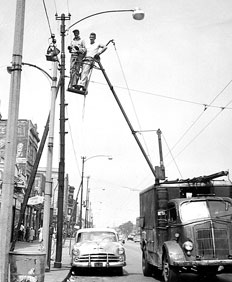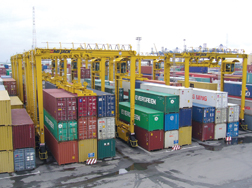 Lanco International Inc. Early boom truck.
|
Just about the only thing that the closely held firm shouts is its slogan, “Where Service is Golden.” Clients have heard that every time they call the office of Hazel Crest, Ill.-based Lanco International Inc. since it set up shop in 1955.
Lanco is better known by its subsidiary, Mi-Jack Products Inc., a moniker that 80-year-old founder Jack Lanigan Sr. forged by combining the names of his first two sons, Michael and Jack. “I tried to design a company for my sons and for a company that I would like to work for,” says Lanigan. He tried to retire at 65, but got the itch for iron and came back to work.
Lanco faces fierce competition for cranes that move bulky objects fast and cheap inside ports, rail yards and precast operations. Besides cranes, its secret is its ability to offer complete intermodal operations.
 Lanigan
|
Early on, fate took a nasty turn when Lanigan wasn’t paid for a shipment to Cuba. That first lesson in international trade shook up the boom-truck venture but paid off later when Lanigan shifted into rubber-tire gantries. “When I was a lineman I was always taught to look ahead three or four moves,” he says.
Early on, Lanigan saw the Interstate as a threat to railroads. He envisioned gantries, used to pick up heavy boats, as a way to help rail compete. In 1975, Mi-Jack became an exclusive dealer for Drott Travelift and developed key patents for container grapples and locks. It eventually bought the gantry line from J.I. Case in 1984. In 1987, Drott’s chief engineer, Gerald Lamer, founded Shuttlelift and became Mi-Jack’s main U.S. competitor.
Lanco has since spread globally. It once ran a port in Argentina and now runs the Panama Canal Railroad in a 50/50 joint venture with the Kansas City Southern Railroad. It also is developing a 350-acre luxury resort in the Bahamas. “They have their fingers in an awful lot of pies,” says Stuart Anderson, a crane equipment analyst in Hagerstown, Md.
 Lanco International Inc. Gantries that juggle containers.
|
Lanco markets itself in innovative ways. Its dealership, which was sold to United Rentals in 1999, was in 1980 the first to hold a backhoe “rodeo,” where operators tested their skills to earn cash prizes. Case adopted the sales gimmick and still holds dozens of rodeos each year.
As Mi-Jack evolved, business grew as trucks, rail and ships became interconnected. In construction, the cranes also help erectors move materials that are getting bigger and bulkier. “They are our livelihood,” says Mike Spruill, president of Gulf Coast Pre-Stress Inc., Pass Christian, Miss. Spruill credits Mi-Jack’s “golden” service for helping him recover soon after Hurricane Katrina swamped his yard.
Each year, Mi-Jack builds about 100 gantry cranes costing between $300,000 and $2 million. It is developing new technologies, such as automated guidance, that make it easier for operators to load and track containers, precast segments and other items.
As a manufacturer, the $500-million-a-year firm also has a unique perspective by operating 65 intermodal terminals, where it gets to run its own cranes. Some of them are decades old. There’s a reason, says Lanigan: “Our engineers design alongside our master mechanics.”
ome suppliers like to brag out loud that they �think globally, act locally.� One crane company tucked away in Chicago�s south side does it without making a lot of noise. Lanigan began as an electrical lineman in Chicago but was quickly frustrated by parked cars that blocked access to utility poles. In 1957, he received a patent for one of the first truck-mounted cranes with a rotating boom.

Post a comment to this article
Report Abusive Comment